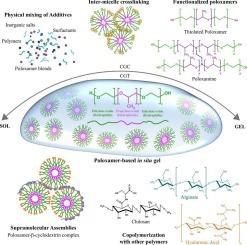原位胶凝系统的工程poloxomer共聚物:结构、组成和功能修饰
IF 6.3
2区 化学
Q1 POLYMER SCIENCE
引用次数: 0
摘要
聚环氧乙烷(PEO)和聚环氧丙烷(PPO),以PEOX-PPOY-PEOX结构排列,构成了两亲性三嵌段共聚物家族,称为poloxamers,是非常有前途的温度响应型原位凝胶平台,用于有效的药物输送。由于基于poloxmer的系统在室温下保持液体,因此它们可以更方便地给药。当暴露于升高的温度时,它们独特的热响应行为诱导胶束自组装,随后在生理温度下从溶胶到凝胶转变,从而实现持续的药物释放。然而,poloxamers在水凝胶体系中的应用主要受到其机械性能不足和相互连接的水结构(加速凝胶侵蚀和药物扩散)的限制。poloxomer共聚物的性质、组成和浓度是决定原位胶化基质中药物扩散程度的最重要因素。许多研究着眼于延长药物释放,增加在给药部位的停留时间,并诱导对基于泊洛沙莫的凝胶的刺激响应特性,探索通过与添加剂的物理共混或化学交联来改变凝胶特性,以及根据所需的治疗应用对泊洛沙莫进行化学功能化。本文综述了波洛沙姆共聚物的重要结构和组成方面,以及旨在改善其物理化学性能的战略性分子修饰。本文章由计算机程序翻译,如有差异,请以英文原文为准。

Engineering poloxamer copolymers for in situ gelling systems: Structural, compositional, and functional modifications
Poly(ethylene oxide) (PEO) and poly(propylene oxide) (PPO), organized in PEOX-PPOY-PEOX configuration, constitute the family of amphiphilic triblock copolymers known as poloxamers, which serve as highly promising temperature-responsive in situ gelling platforms for effective drug delivery. Since poloxamer-based systems remain liquid at room temperature, they can potentially be administered with greater convenience. When exposed to increased temperatures, their unique thermoresponsive behavior induces micellar self-assembly, followed by sol-to-gel transition at physiological temperatures, enabling sustained drug release. However, the application of poloxamers for hydrogel systems has been primarily restricted by their insufficient mechanical properties and an interconnected aqueous structure, which accelerates gel erosion and drug diffusion. The nature, composition, and concentration of poloxamer copolymer serve among the most substantial functions in determining the degree of drug diffusion from the in situ gelling matrix. Focusing on prolonging drug release, enhancing residence time at the administration site, and inducing stimuli-responsive properties to poloxamer-based gels, numerous studies have explored modifying gel characteristics through physical blending or chemical crosslinking with additives, as well as chemical functionalization of poloxamers, depending on desired therapeutic application. This review explores the significant structural and compositional aspects of poloxamer copolymers, along with the strategic molecular modifications aimed at improving their physicochemical properties.
求助全文
通过发布文献求助,成功后即可免费获取论文全文。
去求助
来源期刊

European Polymer Journal
化学-高分子科学
CiteScore
9.90
自引率
10.00%
发文量
691
审稿时长
23 days
期刊介绍:
European Polymer Journal is dedicated to publishing work on fundamental and applied polymer chemistry and macromolecular materials. The journal covers all aspects of polymer synthesis, including polymerization mechanisms and chemical functional transformations, with a focus on novel polymers and the relationships between molecular structure and polymer properties. In addition, we welcome submissions on bio-based or renewable polymers, stimuli-responsive systems and polymer bio-hybrids. European Polymer Journal also publishes research on the biomedical application of polymers, including drug delivery and regenerative medicine. The main scope is covered but not limited to the following core research areas:
Polymer synthesis and functionalization
• Novel synthetic routes for polymerization, functional modification, controlled/living polymerization and precision polymers.
Stimuli-responsive polymers
• Including shape memory and self-healing polymers.
Supramolecular polymers and self-assembly
• Molecular recognition and higher order polymer structures.
Renewable and sustainable polymers
• Bio-based, biodegradable and anti-microbial polymers and polymeric bio-nanocomposites.
Polymers at interfaces and surfaces
• Chemistry and engineering of surfaces with biological relevance, including patterning, antifouling polymers and polymers for membrane applications.
Biomedical applications and nanomedicine
• Polymers for regenerative medicine, drug delivery molecular release and gene therapy
The scope of European Polymer Journal no longer includes Polymer Physics.
 求助内容:
求助内容: 应助结果提醒方式:
应助结果提醒方式:


